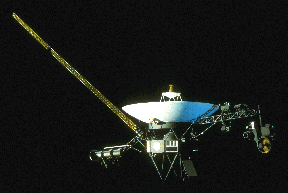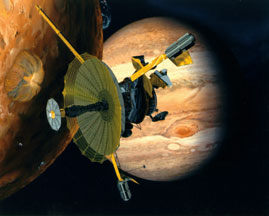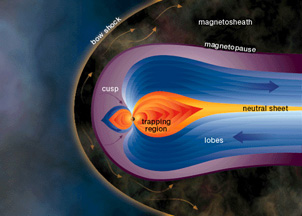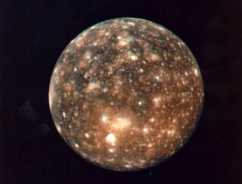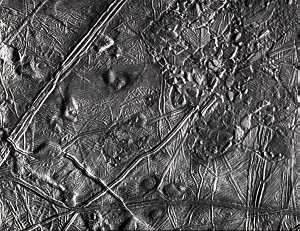
Image courtesty NASA/JPL.
Related links:
Galileo
The Galileo spacecraft was launched on October 19, 1989. Galileo had two parts: an orbiter and a descent probe that parachuted into Jupiter's atmosphere. Galileo's primary mission was to explore the Jovian system (Jupiter and its moons and rings) more thoroughly than was done by the Voyager missions of 1979 and 1980. The Galileo mission ended on September 21, 2003, when mission controllers sent the orbiter on a fiery plunge into Jupiter's atmosphere.
The Galileo mission was a huge success! Originally, the Galileo orbiter was expected to last about two years in orbit around Jupiter. Despite constant bombardment by intense radiation in the magnetosphere of Jupiter, Galileo continued to function for eight years. It returned hundreds of stunning pictures of the four large Galilean moons of Jupiter (Io, Europa, Ganymede, and Callisto) over the course of more than thirty swoops through the inner parts of the Jovian system.
Galileo arrived at Jupiter in December 1995. On December 7, 1995, Galileo's probe made a dangerous descent into Jupiter's atmosphere, encountering 400 mph winds and deceleration forces 250 times stronger than Earth's gravity. The friction the probe encountered as it went screaming into Jupiter's atmosphere heated it to temperatures twice as high as those at our Sun's surface. Although it did not carry a camera, the probe's instruments measured atmospheric pressure, density, and composition, and explored the planet's radiation belts. Low oxygen content and little lightning indicated a surprisingly low concentration of water, which has caused scientists to change their hypotheses about the planet's original formation.
The orbiter made many discoveries during its eight years looping around Jupiter. It gathered evidence for subsurface liquid layers of salt water on Europa, Ganymede, and Callisto. It documented high levels of volcanic activity on Io. When Shoemaker-Levy slammed into Jupiter in 1994, Galileo had the only direct view of the comet striking Jupiter's atmosphere. Galileo determined that Jupiter's rings are formed from dust hurled up by meteor impacts on planet's the inner moons. Measurements by the orbiter's magnetometer revealed that Io, Europa, and Ganymede have metallic cores, while Callisto does not. Also, Galileo discovered that Ganymede generates its own magnetic field; it is the first moon know to do so. The orbiter also found that Europa, Ganymede, and Callisto all have thin, 'surface bound' atmospheres.
During it's trip from Earth to Jupiter, Galileo passed by and studied two asteroids. Galileo was the first spacecraft to fly by an asteroid when it passed Gaspra in 1991. In 1993, Galileo flew past the asteroid Ida and made the first discovery of a moon orbiting an asteroid - the tiny rock Dactyl.






